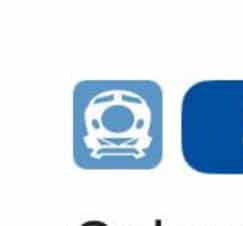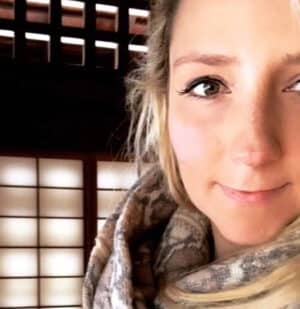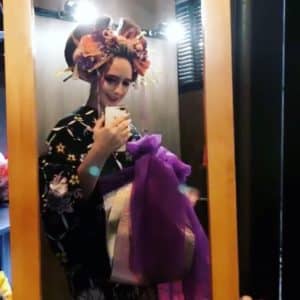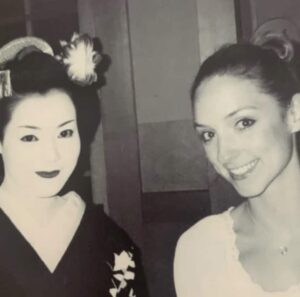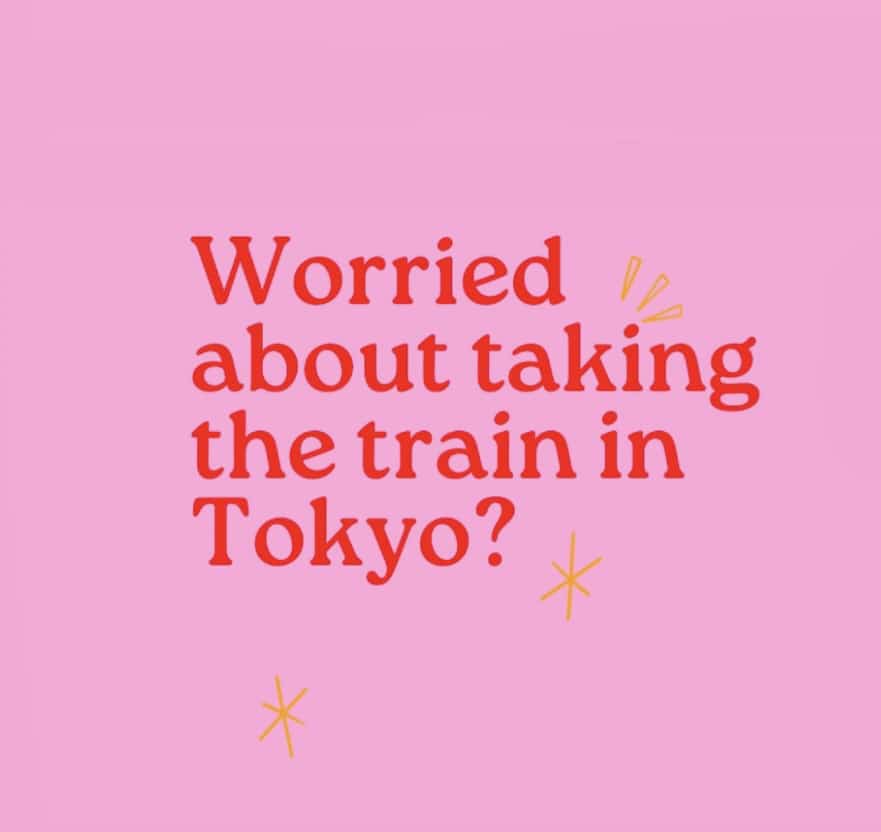
I have so many people who have severe anxiety about whether or not they will be able to manage the train system in Japan.
I’m writing this just like I would write this to any good friend of mine who is feeling anxious about navigating the Japanese train system.
No judgement at all – but I am going to go in full “this is what you’re going to do then” Mum mode.
*And, I would like to note that almost everyone who says this to me – says it to me before they arrive in Japan and feel instantly assured after day one in Tokyo. But I do know that doesn’t help when you’re almost about to leave for your Japanese holiday.
I totally understand why you are nervous.
You’ve probably googled and brought up a massive image of the train network and it looks like a big, confusing, rainbow worm farm, right?
And then someone gets in your ear and says something like “did you hear that there are different companies that all own different types of lines too? So one ticket won’t work for all train networks?” “Are you going to get a JR West Pass, or the standard JR Pass …what about a subway 72 hour pass?” (Really helpful with those nerves, right? So helpful.)
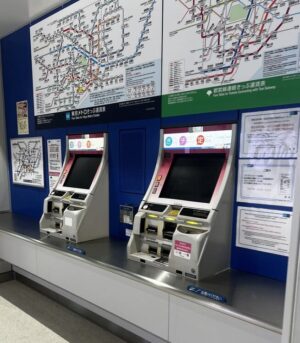
So here is my hand-holding advice for all of my friends here who are confused and concerned about taking trains in any major cities in Japan.
MY STERN, YET LOVING, ADVICE FOR TAKING TRAINS IN JAPAN #1
Ok. Let me get more on the stern side.
See all of the train lines when you google online or above the ticket vending machines at the station? Cool, confusing and overwhelming, right?
Wondering where those colourful lines all go to? Wondering if why there is a map next to it on the map with different lines? Wondering why the person next to you has a green card and another person has an orange paper ticket?
Nope.
Where all the train lines go ? IT’S. NONE. OF. YOUR. BUSINESS
The ticket the person next to you has? NONE. OF. YOUR. BUSINESS.
I’m serious.
The people who I see getting all flabbergasted and confused are always the types who are like “okay -just let me sit down for a second and master how the train system works.”
Are you bananas?
Nope.
You don’t need to do that.
YOU ONLY NEED TO WORRY ABOUT YOU AND WHERE YOU NEED TO GO. The end.
If you need to take the orange line. In busier stations, say it in your head over and over “orange line. orange line” until you’re at the spot you need.* Bonus points if you can remember the name of that orange line too (eg. “JR Chuo Line. JR Chuo Line.”) – then you can ask station staff as you go too. Example: “Excuse me, where is the _______ Line platform?” (incase you wanted to try it in Japanese. すみません、_____線ホームはどこですか? Sumimasen, _______ sen ho-mu wa doko desu ka?). Remember that the answer will be two platforms as train lines go in two directions, of course. They are almost always on either side of one platform. For example, the JR Chuo Line platforms at Tokyo Station are platforms 1 and 2.
If you need exit B14. In your head “B14. B14.” Do it.
Japanese people who have never lived anywhere else and take the train daily – they don’t know where all the lines go.
Most people only know the connections they need to get to where they need to go daily. They may also know the changes they make and need to get to their doctor’s appointment or their Granny’s house.
For everything else? They are also just looking it up – just like you and I.
There are lots of travel apps and websites you can use. But, to keep it simple, I use Google Maps and I recommend you do too. In Japan, the detail of Google Maps is next level when it comes to public transport. As I talk about in my other blog post about the joys of Google Maps in Japan here , Google Maps will guide you door to door -but on trains? It will also give you platform numbers, exit numbers, ticket prices and which platform to change to if you have to change trains. And my favourite part? If you got on a train a few minutes after Google suggested (like if you stopped to get a vending machine drink or needed to use the restroom etc) – it can self correct when you start the route again.
You put in your start and end point in Google Maps.
It will come up with a range of options. The first 2-3 are usually the best as Google Maps does go for the shortest amount of travel time.
Remember that you can play with all of the search filters too (just click “Options” in the top right of the map portion of the screen.)
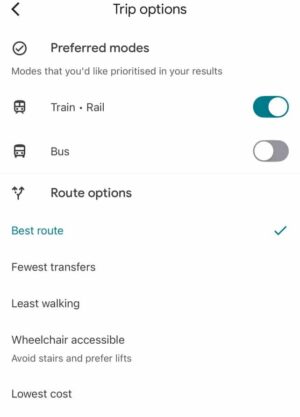
Don’t forget to take note of the station exit closest to your final destination. Big train stations have many exits to pop out of – and the “wrong” exit could mean you have to back track another 20 mins or so to get to where you need to (not the end of the world, of course, but better to aim for the right one, yes?)
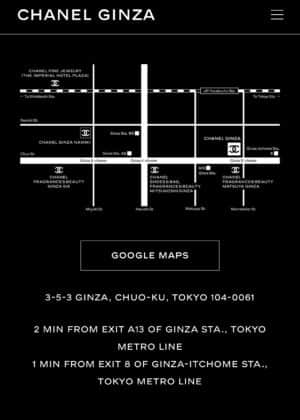
So – pick your Google Maps suggested route. Follow it.
You’re good to go – let Google Maps do all the thinking and logistics for you. The trains all have different times by the minute for a reason. If google maps wants to put you on a train at 12:33pm that may be because it’s a limited express or something and may save you 20 mins of travel time. If you miss the 12:33pm, just refresh the google maps and start again and see what the next option is (don’t just go jumping on the next train at the same platform- leave your brain out of it – Google Maps is your new brain now.) Oh and don’t go running for trains- unless it’s after 9pm and you have a long way to travel back – trains come frequently .. no need to run around panicking.
Google Maps also alleviates the stress of any language barrier concerns too.
On the train route, there is also a drop down arrow that includes all of the stations that you will stop at. So you can follow along to double check how many stops there are to go (my kids love knowing “how many stops we have”) OR you could just look at the arrival time at your station and stare out the window until 2-3 mins before that scheduled time.
What everyone else is doing – NONE. OF. YOUR. BUSINESS.
See here if you’d like to read up on my advice regarding mindful train travel in Japan.
*ADVICE:FOR TRAIN OR BULLET TRAIN TRAVEL IN JAPAN*
If a ticket gate machine doesn’t “eat up” your ticket as you go through a ticket gate. DO NOT throw it in the bin. Keep it. Keep it! Some stations have secondary gates or you need to show it again when you make a transfer. Keep that ticket. Even if you have to throw it away in your hotel instead? Keep that ticket! It will make life easier if you do come across another “check point” where you need it and, potentially, it can save you money.
MY STERN, YET LOVING, ADVICE FOR TAKING TRAINS IN JAPAN #2
DON’T PUT NORMAL TRAINS AND SHINKANSENS (BULLET TRAINS) IN THE SAME CATEGORY IN YOUR HEAD
Bullet trains you don’t really need my help with. You can buy bullet train tickets ahead of time if you want to (I explain options here) but you can also buy them on the day – it’s not like taking a flight -it’s still a train. You can buy tickets ahead of time if you’re travelling with a large group, if you are travelling during busy periods (the New Years’ period, Golden Week, Obon) or if it just makes you feel less anxious. But most Japanese people will buy tickets on the day or 1-2 days ahead of time.
The reason you don’t need my advice much for bullet train travel?
1) It’s easy to work out
2) It’s very English friendly
3) The staff are used to helping people with tickets and platform numbers etc.
So -work out how to get yourself to the bullet train station (most commonly bullet train stations used in Tokyo are Tokyo Station and Shinagawa Station – particularly if you’re going between Tokyo and Kyoto etc) on a “normal train” like I talk about in my #1 tip and then do the same from the bullet train station at the other end to your hotel (or wherever you need to get to.)
MY STERN, YET LOVING, ADVICE FOR TAKING TRAINS IN JAPAN #3
YOU DON’T HAVE TO USE ALL THE SNAZZY RAILWAY PASSES IN JAPAN.
They don’t always save LOTS AND LOTS of money (especially if you’re not in Japan for long and are just getting between the usual touristy spots) and if they are causing you more stress than fun ? Who cares!
Remember, paper tickets are a thing.
You can buy individual paper tickets for getting from A to B using cash.
We often do this as my kids love to look up on the map above the ticket vending machines – find the icon that shows where we are and spot the station of where we want to go to. The number underneath that station name is how much it costs to get to that stop from where you are.
You can do this too.
Paper tickets can sometimes help if you have a brain like mine and just want to pay for each trip portion, move to the next type of train line and then pay for that one then too.
Eg. Let’s say Google Maps says you need to take the JR Yamanote (city loop) line first and a subway second? You can pay for your JR Yamanote line route. Give your paper ticket to the ticket gate as you leave the JR ticket gate – let it gobble it up. Then, at the subway station ticket gate, you buy your next ticket and do the same for that route. Two steps back to back. Easy.
But what happens if I get the ticket price wrong in Japan? Will I be trapped inside the ticket gate?
You won’t !
Japan, of course, has a system for this (Japan has a system for everything so, of course there is a system for this too.)
If, for some reason, your ticket buzzes at the ticket gate machine thingy at the other end, just look for the fare adjustment machine.
*Even if you haven’t put your ticket through the machine yet and you wanted to check that you have paid enough – you can pop it in anyway.
The amount that pops up on the machine is the balance you need to pay. Pop that amount in. New ticket is issued – you are good to go!
If, for some reason, you can’t spot the fare adjustment machine, you can ask a staff member by showing them this.
すみません、乗り越し精算機はどこですか? (If you wanted to try and say it – Sumimasen. Norikoshi seisanki wa doko desu ka?) It means “Excuse me, where is the fare adjustment machine?”
Another tip!
If you got off one station too late? Go and take the train back to the station you initially meant to go to. The fare is only calculated once you’re going through the ticket gates so the “machines” don’t know that you had a little extra ride.
See here on other reasons why it is important to carry some cash on you at all times in Japan.
But what if I don’t want to use paper tickets and prefer a smart travel card?
That is also an option.
It’s especially handy if you don’t want to worry about how much tickets cost or whether you’re on a certain private train line or a subway line etc. A travel card like a suica card covers pretty much every form of transport (except for a few random cash only trams or buses) so if you want comprehensive coverage of all – then this might give you the ultimate “comfort hug” if you’re feeling nervous.
The most straight forward way to get a travel card like a Suica card is to add it to your iphone or apple watch wallet. I speak more about Suica, Pasmo and other travel cards here in more detail and other options such as purchasing a physical card to tap on and off as well.
As I mention in this blog post about travel cards – you need a card (digital or physical) for each person. (Kids under 6 can use the trains for free but older than 6 they need their own Suica or Pasmo cards. If you don’t have devices for them – you will need to get them physical cards or just do paper tickets for them. As I speak about in my Shinkansen Travel with Kids blog post – I recommend buying tickets for kids under 6 on bullet trains for any journey over 30-60 mins as it’s a pain to hold them on your lap the whole time.)
I keep hearing about all of these passes – 72 Hour Subway pass etc. Should I be looking into these?
Let me guess. You heard about them on a third party selling site or an advertisement, right?
They aren’t scammy or anything but they aren’t always necessary either so, if it really interests you – do some research and purchase if it makes sense or, if you’re anxious and it will just take something off your mental load to have something paid for already – go for it.
If you look on google maps, you will see that the subway cost is usually around 120-300 yen (even less for a child) for a short trip – so get out a pen and paper and see if you think you need it and if it will make your trip easier for you and the way you like to travel.
I’m honestly not trying to talk you out of buying any special discount passes – but I am trying to tell you that you don’t need to lose sleep over something like this. Especially if you’re already feeling anxious.
I travelled in Japan 10 years ago and I used a JR Pass. Why aren’t people talking about that now?
Unfortunately, JR pass prices went up considerably in Oct 2023 and I rarely meet anyone who it is now economically viable anymore.
If you would like to check if it is worthwhile for you financially, google “JR Pass calculator” and you can enter all of your big trips and then find out if it makes sense.
I’ve written in more detail about JR Passes here if you’d like to have a read.
MY STERN, YET LOVING, ADVICE FOR TAKING TRAINS IN JAPAN #4
The incredible Japanese systems in place for trains means pretty much any accident or exception has been accounted for (the “fare adjustment machine” advice above included.) Even if you think you’ve been a complete idiot – someone else has probably already done it before you.
And, even better, Japanese station staff are so so kind and almost always* give passengers the benefit of the doubt.
*Understandably they don’t have to be forgiving to those who deliberately fare evade, make other passengers feel uncomfortable or attempt dodgy things like travelling with a JR Pass that doesn’t belong to them etc.
*Advice when travelling with kids and you have paper or physical smart travel cards – KIDS NEVER EVER HOLD ONTO THE CARDS.
I’ve seen cute lanyard ideas for kids etc but, ultimately, I think – once you’re through the ticket gate machines – straight back to the hands of Mum and Dad. My kids love doing the “turnstyles” (they aren’t turnstyles in Japan but you know what I mean) themselves but then know that I hold on to the tickets for the actual journey – and hand them back for the leaving the station bit.
If you like these kind of recommendations for travel with kids – I think you’ll also like to read my family safety rules in Japan here.
Google Maps
Most people already have this on your phone – however, if you don’t use google maps often, I highly highly recommend familiarizing yourself with how to use the app. Learn how to use it to help you get from one spot to the next and how to use the wheelchair accessible filter (this will show you how to easily find elevators when you have a stroller or lots of luggage.)
It is also a good idea to learn what the Shinkansen (aka bullet train) symbol looks like so you will know when you are to catch a normal train vs a bullet train.
